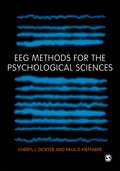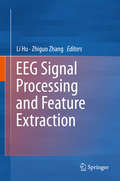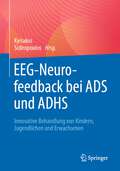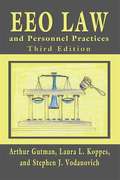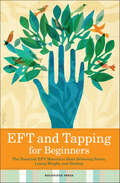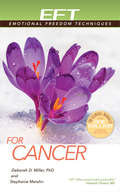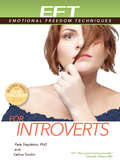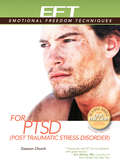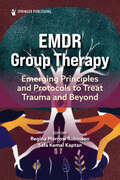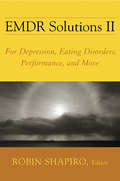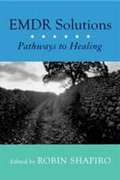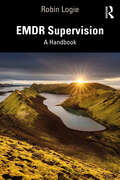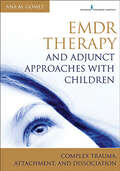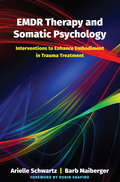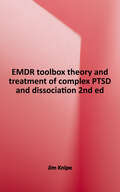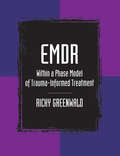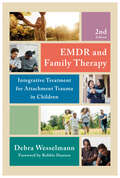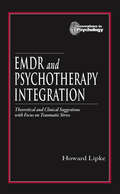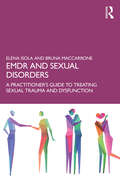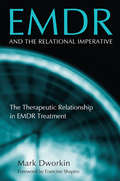- Table View
- List View
EEG Methods for the Psychological Sciences (The\sage Library Of Methods In Social And Personality Psychology Ser.)
by Paul D Kieffaber Cheryl L Dickter"A unique and important resource, full of critical practical knowledge and technical details made readily accessible." - Tiffany Ito, University of Colorado at Boulder "A comprehensive and engaging guide to EEG methods in social neuroscience; Dickter and Kiefabber offer practical details for conducting EEG research in a social/personality lab, with a broad perspective on how neuroscience can inform psychology. This is a unique and invaluable resource - a must-have for scientists interested in the social brain." - David M. Amodio, New York University Electroencephalography (EEG) has seen a dramatic increase in application as a research tool in the psychological sciences in recent years. This book provides an introduction to the technology and techniques of EEG in the context of social and cognitive neuroscience research that will appeal to investigators (students or researchers) wishing to broaden their research aims to include EEG, and to those already using EEG but wishing to expand their analytic repertoire. It can also serve as a textbook for a postgraduate course or upper-level undergraduate course in any area of behavioural neuroscience. The book provides an introduction to the theory, technology, and techniques of EEG data analysis along with the practical skills required to engage this popular technology. Beginning with a background in the neural origins and physical principles involved in recording EEG, readers will also find discussions of practical considerations regarding the recording of EEG in humans as well as tips for the configuration of an EEG laboratory. The analytic methods covered include event-related brain potentials (ERPs), spectral asymmetry, and time-frequency analyses. A conceptual background and review of domain-specific applications of the method is provided for each type of analysis. There's also comprehensive guided analysis for each analytic method that includes tutorial-style instruction and sample datasets. This book is perfect for advanced students and researchers in the psychological sciences and related disciplines who are using EEG in their research.
EEG Signal Processing and Feature Extraction
by Li Hu Zhiguo ZhangThis book presents the conceptual and mathematical basis and the implementation of both electroencephalogram (EEG) and EEG signal processing in a comprehensive, simple, and easy-to-understand manner. EEG records the electrical activity generated by the firing of neurons within human brain at the scalp. They are widely used in clinical neuroscience, psychology, and neural engineering, and a series of EEG signal-processing techniques have been developed. Intended for cognitive neuroscientists, psychologists and other interested readers, the book discusses a range of current mainstream EEG signal-processing and feature-extraction techniques in depth, and includes chapters on the principles and implementation strategies.
EEG-Neurofeedback bei ADS und ADHS: Innovative Behandlung von Kindern, Jugendlichen und Erwachsenen
by Kyriakos SidiropoulosDas Buch ermöglicht Neurowissenschaftlern, Psychotherapeuten, Kinder- und Jugendärzten und -Psychiatern einen Einstieg in die Behandlung von ADS/ADHS mit der Methode des EEG-Neurofeedbacks. Es hilft zudem Ergotherapeuten, die ADHS-Symptomatik besser zu verstehen und die Besonderheiten des EEG-Signals von Kindern, Jugendlichen und Erwachsenen mit ADS/ADHS leichter zu interpretieren. Detailliert stellen die Autoren alle relevanten EEG-Protokolle vor, die in der Praxis Anwendung finden. Beleuchtet werden sowohl die Stärken als auch die Schwächen dieser Methode.
EEO Law and Personnel Practices
by Arthur Gutman Laura L. Koppes Stephen J. VodanovichThe goal of this well known book is to provide methods for understanding major EEO laws, including the Civil Rights Act of 1964, the Equal Pay Act of 1963, and the American with Disabilities Act of 1990. Also included are over 700 cases involving federal case law that focus on issues relating to the terms and conditions of employment. New to this t
EFT and Tapping for Beginners: The Essential EFT Manual to Start Relieving Stress, Losing Weight, and Healing
by Rockridge PressNow there is a simple, effective, noninvasive, and drug-free way to use your body's own healing mechanisms to overcome physical and emotional pain. Emotional Freedom Technique (EFT) and tapping consist of activating energy points along one's body in much the same way acupuncture relieves pain-except without the needles! Energy blockages are cleared quickly and effectively, allowing for healing and a sense of overall well-being. It is a safe and easy way to relieve stress, anxiety, and depression and to control weight gain and physical pain. With EFT and Tapping for Beginners: Practice the basic tapping sequences using helpful illustrations that show you the exact energy points to activate on your head, hands, and torso. Learn how to focus your thoughts and tapping goals with freewriting and journaling. Begin experiencing relief from stress and everyday anxieties. Use tapping to help manage the root causes of weight gain and the physical symptoms associated with diabetes, high blood pressure, persistent pain, and more. EFT and Tapping for Beginners: The Essential EFT Manual to Start Relieving Stress, Losing Weight, and Healing not only helps you learn the tapping process, but also invites you to look at the causes of emotional and physical pain. Begin healing today with this concise guide.
EFT for Cancer
by Stephanie Marohn Deborah D. MillerEFT (Emotional Freedom Techniques) is a self-help tool to alleviate the emotional, mental, and physical struggles that come with cancer. EFT will support you every step of the way on your cancer journey, from diagnosis and decision-making through treatment and recovery.EFT (Emotional Freedom Techniques), commonly called tapping, is an invaluable tool for anyone who is dealing with cancer. Research has shown that it is an effective method for alleviating emotional and psychological upsets as well as physical pain. With all of these factoring into the cancer experience, adding EFT to your healing program is a form of self-care you can implement today. EFT will support you every step of the way on your cancer journey.EFT combines acupressure (tapping on the points) and psychology's exposure therapy and cognitive behavior therapy (focusing on whatever is distressing you). It is easy to learn and apply. EFT for Cancer gives you everything you need to start using EFT now, providing simple instructions, tapping scripts for the myriad issues that arise with cancer, case histories throughout the book showing you how other people have used EFT to deal with their cancer, plus information on the science of EFT as an evidence-based practice.The 14 chapters in the book detail how you can use EFT to address the gamut of cancer experiences: diagnosis shock, common emotions such as fear and anger, physical pain, dealing with medical decisions and treatment, relating to loved ones, asking for and accepting support, clearing regrets, improving body image and self-esteem, talking about your condition, clearing obstacles to healing, special issues women and men with cancer face, death and dying, and self-care for supporters and caretakers, as well as how to use EFT with children.
EFT for Introverts
by Peta Stapleton Celina TonkinIntroversion is not a condition from which you need to recover. Many introverts try to become extroverts and in the process lose themselves and lose sight of the powerful positive traits introverts possess. If you are an introvert, you are in good company: the list includes Leonardo da Vinci, Gandhi, Einstein, and Charles Darwin. Self-proclaimed introverts of today include Warren Buffet, Bill Gates, and Barack Obama.EFT for Introverts, by psychologist Peta Stapleton, PhD, and EFT practitioner Celina Tonkin, offers a quick and easy technique for: Reducing the discomfort of typical situations that are stressful to an introvert Overcoming the limiting beliefs you have about being an introvert Releasing the innate talents and abilities of your introversion, and ... Elevating you to embracing yourself as an introvert. By using EFT (Emotional Freedom Techniques, or "tapping"), you harness the power of one of the most potent self-help tools ever developed. This frees you to be more effective in every area of your life, from career to relationships to health to money to well-being.
EFT for Love Relationships
by Dawson ChurchRelationships can be heaven - or hell. They can take us to the most sublime and happy states, or trap us in endless cycles of misery. Dawson Church has been dedicated for many years to helping people shift their relationships to create warm and deep emotional intimacy. As a scientific researcher, he's investigated which techniques really work to truly make love flourish. These tools, like mindfulness, EFT tapping, and heart coherence, are surprisingly quick and easy to learn, yet produce profound relationship shifts. In this book, he's explains how our hormones and biology drive our behavior, and actually sabotage long-term relationships despite our best intentions. He then guides you into creating deep and lasting change. If you're ready for a radically different experience, and a whole new relationship future, this book is for you.
EFT for PTSD
by Dawson ChurchPost-traumatic Stress Disorder (PTSD) is a terrible burden to bear. It not only affects people psychologically, robbing them of peace of mind and inner tranquility; it damages them physically. Traumatic stress can result from negative emotional experiences during childhood. It can also arise in adults as a result of war, assault, or similarly traumatic experiences. Some of the symptoms of PTSD are:. Insomnia. Digestive disorders. Flashbacks and nightmares. Irritability, jumpiness, being easily triggered by events. Rage, grief and guilt. Anxiety, panic attacks, depression. Feeling isolated and unsafeIf you or someone you know has these symptoms, EFT can help. In scientific studies of war veterans and other traumatized groups, EFT has been shown to reduce or eliminate PTSD, sometimes in just a few short sessions. Not only do PTSD sufferers experience immediate relief, but the positive results extend long after treatment. This manual is a lifeline for those suffering from PTSD and their families. It also contains special sections that gather together the experience of many physicians, psychotherapists, social workers and coaches who have used EFT.
EIDETIC IMAGERY and Typological Methods of Investigation: Their Importance for the Psychology of Childhood, the Theory of (International Library Of Psychology Ser.)
by Jaensch, E RFirst published in 1999. Routledge is an imprint of Taylor & Francis, an informa company.
EMDR Group Therapy: Emerging Principles and Protocols to Treat Trauma and Beyond
by Safa Kemal Kaptan Regina Morrow Robinson EdSDelivers an EMDR model that can expand access to urgently needed mental health services while maintaining affordability <P><P> This innovative handbook is the first to present EMDR Group Therapy as a pragmatic approach to trauma care that enables practitioners to scale up mental health services while ensuring cost and time efficiency. It delivers step-by-step guidance—supported by real-life case examples—for practicing this safe, effective, and culturally adaptable modality in a wide range of situations and conditions. EMDR group protocols are applicable to inpatient and outpatient settings, strangers experiencing similar or different events, families, and a wide range of ages. The book explores how and why EMDR group protocols are applicable to disaster response, addictions, schools, medical challenges, grief, families, refugees, victims of sexual violence, emergency responders and more.
EMDR Solutions II: For Depression, Eating Disorders, Performance, And More
by Robin Shapiro Celia GrandA clear and comprehensive guide to using EMDR in clinical practice. This edited collection—a follow-up to Shapiro’s successful EMDR Solutions—presents step-by-step instructions for implementing EMDR approaches to treat a range of issues, written by leading EMDR practitioners. The how-to approach, mixed with ample clinical wisdom, will help clinicians excel when using EMDR to treat their clients. The units include: A comprehensive compendium of EMDR interventions for Depression, it begins with Robin Shapiro’s Assessment, Trauma-Based and Endogenous Depression chapters, continues with Jim Knipe’s Shame-Based Depression chapter, and ends with Shapiro’s Attachment-Based chapter. The eight chapters of the Eating Disorder unit cover all the bases. From etiology to neurology through Preparation phases and treatment strategies, you’ll learn how to work with Bulimia, Anorexia, Body Dysmorphia, Binge Eating Disorder, disorders of Desire and more. Andrew Seubert is the ring leader. The other writers are Janie Scholom, Linda Cooke, Celia Grand, DaLene Forester, Janet McGee, Catherine Lidov, and Judy Lightstone. Performance, Coaching, and Positive Psychology unit emphasizes strengths, skills, focus, and whatever gets in the way of reaching the goal. David Grand shares his foundational 15 Strategies for Performance enhancement. Ann Marie McKelvey integrates EMDR with Coaching and Positive Psychology. The Complex Trauma unit includes Katie O’Shea’s useful and user-friendly Preparation Methods and Early Trauma Protocol, Sandra Paulsen and Ulrich Lanius’s brilliant collaboration Integrating EMDR with Somatic and Ego State Interventions, Liz Massiah’s hair-raising Intrusive Images chapter, and Shapiro’s treatment strategies for OCPD. Robin Shapiro gives an overview of Medically-Based Trauma and her strategies for successful treatment of Multiple Chemical Sensitivities. Katherine Davis shows us how Post-Partum “Depression” is often treatable Post-Partum PTSD. Ronald Ricci and Cheryl Clayton tell us how to use EMDR in our work with Sex Offenders and their complete therapeutic milieu. Martha S. Jacobi develops our “third ear” for using EMDR with Religious and Spiritually-Attuned clients. Contributors include: Cheryl Clayton, LCSW, Linda J. Cooke, LCSW, BCD, DaLene Forester, PhD, LMFT, David Grand, PhD., The Reverend Martha S Jacobi, M.Div., LCSW, Jim Knipe, PhD, Dr. Ulrich Lanius, Catherine Lidov, MSW, LCSW, Judy Lightstone, PhD, MA, MS, Elizabeth Massiah , MSW, RSW, Reg. Psychologist, Janet McGee, LCSW, Ann Marie McKelvey, LPCC, PCC, Katie O’Shea, MS, LMHC, Sandra Paulsen, PhD, Ronald J. Ricci, PhD, Janie Scholom, BSN, LCSW, Andrew Seubert, LPC, NCC.
EMDR Solutions: Pathways to Healing
by Robin ShapiroIn EMDR Solutions you will find fifteen exemplary EMDR solutions, each of which develops the Standard Protocol in creative and highly effective ways. These solutions move EMDR forward and expand the application of this powerful therapeutic approach. In this source book of therapeutic strategy and clinical insight, each chapter presents step-by-step instructions for implementing a particular EMDR solution with clients. Each intervention is enriched with relevant case histories that bring to life new targets for and variations on the standard EMDR protocol. Concrete and specific, the clinical work illustrated here will add to you fund of knowledge and broaden your practice.
EMDR Supervision: A Handbook
by Robin LogieThis unique handbook provides a guide for supervisors of therapists who use Eye Movement Desensitisation and Reprocessing (EMDR) therapy, and those undergoing training in EMDR supervision. Whilst drawing on the literature on supervision theory and research, this book provides a down-to-earth guide to this topic, focusing on the European system of accreditation. The book guides the EMDR supervisor and supervisor-in-training in the difficult task of balancing the roles of educator, enabler, and evaluator. Using the author’s unique blend of warmth, humour, and humility, the book includes vignettes of real-life situations encountered by the author and provides practical solutions to dilemmas encountered in EMDR supervision.
EMDR Therapy and Adjunct Approaches With Children: Complex Trauma, Attachment, and Dissociation
by Ana M. GomezThis is the first book to provide a wide range of leading-edge, step-by-step strategies for clinicians using EMDR therapy and adjunct approaches with children with severe dysregulation of the affective system. Written by an author internationally known for her innovative work with children, the book offers developmentally appropriate and advanced tools for using EMDR therapy in treating children with complex trauma, attachment wounds, dissociative tendencies, and compromised social engagement. The book also presents the theoretical framework for case conceptualization in EMDR therapy and in the use of the Adaptive Information Processing (AIP) model with children.
EMDR Therapy and Somatic Psychology: Interventions To Enhance Embodiment In Trauma Treatment
by Robin Shapiro Arielle Schwartz Barb MaibergerA guide to help EMDR practitioners to integrate somatic therapy into their sessions. Clients who have experienced traumatic events and seek EMDR therapists rely on them as guides through their most vulnerable moments. Trauma leaves an imprint on the body, and if clinicians don't know how to stay embodied in the midst of these powerful relational moments, they risk shutting down with their clients or becoming overwhelmed by the process. If the body is not integrated into EMDR therapy, full and effective trauma treatment is unlikely. This book offers an integrative model of treatment that teaches therapists how to increase the client's capacity to sense and feel the body, helps the client work through traumatic memories in a safe and regulated manner, and facilitates lasting integration. Part I (foundational concepts) offers a broad discussion of theory and science related to trauma treatment. Readers will be introduced to essential components of EMDR therapy and somatic psychology. The discussion then deepens into the science of embodiment through the lens of research on emotion, memory, attachment, interpersonal neurobiology, and the impact of trauma on overall health. This part of the book emphasizes the principles of successful trauma treatment as phase-oriented, mindfulness-based, noninterpretive, experiential, relational, regulation focused, and resilience-informed. Part II (interventions) presents advanced scripted protocols that can be integrated into the eight phases of EMDR therapy. These interventions provide support for therapists and clients who want to build somatic awareness through experiential explorations that incorporate mindfulness of sensations, movement impulses, breath, and boundaries. Other topics discussed include a focus on complex PTSD and attachment trauma, which addresses topics such as working with preverbal memories, identifying ego states, and regulating dissociation; chronic pain or illness; and culturally-based traumatic events. Also included is a focused model of embodied self-care to prevent compassion fatigue and burnout.
EMDR Toolbox: Theory and Treatment of Complex PTSD and Dissociation
by Jim KnipeThis innovative resource for therapists trained in Standard EMDR delivers a powerful set of EMDR-based “Tools” - useful strategies for helping difficult-to-treat clients with complex emotional problems. The second edition reflects the author’s ongoing efforts to design treatments that can significantly extend the therapeutic power of methods based on an Adaptive Information Processing model. It describes new discoveries that promote effective ways of structuring therapy sessions and refines original treatment procedures that can facilitate and safely accelerate therapeutic progress. <p><p>EMDR Toolbox provides an overview of the principal issues in treating these complex emotional problems and describes highly effective methodologies with a wide variety of clinical presentations that originate in or include disturbing traumatic memories. It also describes how to integrate specific EMDR-related interventions with other psychotherapeutic treatments. Each intervention is examined in detail with accompanying transcripts, client drawings, and case studies illustrating the nuances and variations in intervention application. Bolstered by supporting theory and current research, this EMDR book also discusses how the concepts and vocabulary of other models of dissociation translate directly into EMDR's Adaptive Information Processing (AIP) language. <p><p>New to the Second Edition: <p>•Describes new strategies and refinements of standard methods for treatment of clients with complex emotional problems <p>•Includes two completely new chapters, “Internal Healing Dialogue” and “Case Example: treating the problem of ‘attachment to the perpetrator’” <p>•Provides new case examples on childhood sexual abuse <p>•Offers new sections on treating chronic defensive shame, the importance of “fast” vs “slow” thinking processes, and new applications of “Loving Eyes” procedures <p><p>Key Features: <p>•Written by an EMDRIA-designated “Master Clinician” <p>•Delivers successful treatments alternatives for difficult-to-treat clients <p>•Provides a theoretical framework to guide assessment and treatment of clients with complex PTSD <p>•Includes specific AIP tools, verbatim therapy scripts, client drawings, and case studies <p>•Discusses each intervention in detail, illustrating the nuances and variation in different applications
EMDR Within a Phase Model of Trauma-Informed Treatment
by Ricky GreenwaldA practical guide to learning and using EMDR Trauma is a potential source of most types of emotional or behavioral problems. Extensive research has shown EMDR to be an effective and efficient trauma treatment. EMDR Within a Phase Model of Trauma-Informed Treatment offers mental health professionals an accessible plain-language guide to this popular and successful method. The book also introduces the "Fairy Tale Model" as a way to understand and remember the essential phases of treatment and the tasks in each phase. This manual teaches a clear rationale and a systematic approach to trauma-informed treatment, including often-neglected elements of treatment that are essential to preparing clients for EMDR. The reader is led step by step through the treatment process, with scripted hands-on exercises to learn each skill. In addition to presenting the fundamental EMDR procedures, EMDR Within a Phase Model of Trauma-Informed Treatment teaches a treatment system that can be applied to a variety of cases. Using research-supported and proven-effective methods, this book takes you through the treatment process with easily-understood dialogues and examples. Explicitly guided exercises produce hands-on skills and familiarize you with ways to explain trauma to clients and prepare them for EMDR. You will also learn to problem-solve challenging cases using the trauma framework. EMDR Within a Phase Model of Trauma-Informed Treatment also includes an Instructor&’s Manual with: sample syllabus teaching tips PowerPoint slides test bank.Additional discussions address: why trauma matters posttraumatic symptoms the "trauma wall" the structure of trauma treatment the role of EMDR the eight phases of EMDR preparing clients for EMDR legal and medical issues in EMDR problem solving strategies in EMDR sessions treatment strategies for a variety of presenting problems using EMDR with children and adolescents use and application of the "fairy tale model" on-line and digital resourcesDesigned to be a comprehensive primer, companion/supplemental textbook, and valuable reference resource, EMDR Within a Phase Model of Trauma-Informed Treatment is ideal for clinicians already trained in EMDR, those actively learning EMDR, and mental health professionals interested in EMDR. Note that to practice EMDR requires formal supervised training.
EMDR and Creative Arts Therapies
by Elizabeth DavisThis book guides therapists trained in EMDR in the successful integration of the creative arts therapies to make the healing potential of EMDR safer and more accessible for patients who present with complex trauma. Contributors from the respective fields of creative and expressive arts therapies offer their best ideas on how to combine EMDR with these therapies for maximum benefit for people from diverse backgrounds, orientations, and vulnerable populations. Chapters offer detailed case studies and images, insightful theoretical approaches, and how-to instructions to creatively enhance clinical work. Additionally, the book addresses current critical issues in the field, including the importance of an integrative and open approach when addressing cultural, racial and diversity issues, and creative interventions with clients through teletherapy. Creative arts therapy practitioners such as art therapists, play therapists, and dance/movement therapists will find this a compelling introductory guide to EMDR.
EMDR and Family Therapy: Integrative Treatment for Attachment Trauma in Children
by Debra WesselmannA practical guide to treating children suffering from early attachment trauma—now updated and revised. Loss of a parent, separations, abuse, neglect, or a history of a difficult foster or orphanage experience can lead to profound emotional dysregulation in children. Working with these children can feel overwhelming for clinicians. But by integrating EMDR with family therapy, clinicians can strengthen parent–child attachment bonds and help to mend the early experiences that drive a traumatized child’s behavior. This manual—an update to Debra Wesselmann’s popular Integrative Team Treatment for Attachment Trauma in Children—provides clear, step-by-step application of the Integrative Attachment Protocol for Children (IATP-C). In this treatment, psychoeducation assists parents in developing trauma-informed responses to their children’s challenging behaviors, while family therapy and EMDR therapy deepen children’s bonds with parents; improve self-awareness, self-regulation, and self-worth; and assist children with making sense of their traumatic pasts. Any EMDR-trained clinician—or any clinician pairing with an EMDR therapist—can implement this treatment approach to heal suffering from attachment trauma and offer children and their families a better future.
EMDR and Psychotherapy Integration: Theoretical and Clinical Suggestions with Focus on Traumatic Stress (Innovations in Psychology Series)
by Howard LipkeInitially regarded as one of the most peculiar methods of psychotherapy ever devised, EMDR (eye movement desensitization and reprocessing) was introduced to psychotherapists 11 years ago when Dr. Francine Shapiro reported demonstrable rapidly effective treatment results. An early endorsement by the late Dr. Joseph Wolpe, a founder of behavior thera
EMDR and Sexual Disorders: A Practitioner’s Guide to Treating Sexual Trauma and Dysfunction
by Elena Isola Bruna MaccarroneEMDR and Sexual Disorders provides fundamental guidelines for the treatment of sexual dysfunctions with EMDR (Eye Movement Desensitization and Reprocessing) within the conceptual framework of attachment theory.This book demonstrates how the EMDR method, which works specifically on the reprocessing of traumatic memories, can be used to addresses the overall well-being of the patient with the goal of restoring a state of 'sexual health'. The goal is not only the absence of dysfunctions and diseases but a general condition of physical, emotional, mental and social well-being. After a thorough examination of sexual pathologies and dysfunctions, the authors focus on the traumatic origin of sexual disorders, drawing on extensive clinical experience with victims of abuse and negative attachment stories. A clear and documented picture emerges of how EMDR can provide an innovative and effective contribution to the treatment of pathologies so closely connected to the patient’s personal history. The book also introduces two new ground-breaking tools for practitioners: the EMDR protocol for individual sexual dysfunction and the EMDR protocol for sexual dysfunction within couples.This book offers key essentials to EMDR therapists and any health professional (psychologists, doctors, social workers etc.) who work in the field of sexology.
EMDR and the Energy Therapies: Psychoanalytic Perspectives
by Phil MollonEye Movement Desensitization and Reprocessing (EMDR), along with methods from the new field of energy psychology, such as the Emotional Freedom Techniques (EFT), enable the rapid processing and release of traumatic memories and painful emotion. In this innovative work, Phil Mollon demonstrates how the perspectives of EMDR, energy psychology, and psychoanalysis can inform and enrich each other. By summarising relevant research and providing many clinical examples, Mollon has produced a challenging and invigorating scrutiny of psychoanalysis and an expanded vision of the potential for psychosomatic healing.
EMDR and the Relational Imperative: The Therapeutic Relationship in EMDR Treatment
by Mark DworkinIn this groundbreaking work, Mark Dworkin, an EMDR teacher, facilitator, and long-time practitioner, explores the subtle nuances of the therapeutic relationship and the vital role it plays in using Eye Movement Desensitization and Reprocessing (EMDR) with traumatized clients. Showing how relational issues play a key role in each phase of EMDR treatment, the author provides tools for the therapist to more efficiently apply this method in the treatment of trauma victims and form a stronger and healthier relationship with the patient. A standard reference for all practitioners working to heal the wounds of trauma, this book will be an essential resource for the effective application of EMDR.
EMDR in Family Systems: An Integrated Approach to Healing Trauma
by Diana MilleEMDR in Family Systems provides clinicians with a clear account of the EMDR process and a comprehensive, step-by-step approach to healing trauma through integrating EMDR with other therapeutic tools. The book provides a unique protocol utilizing numerous evidence-based diagnostic assessments; in-depth psychoeducation on attachment issues, Internal Family Systems therapy, and mindfulness; and Metaframeworks, a Family Systems modality, as a model to enhance EMDR. Filled with a wealth of information on the latest clinical studies on topics from the neurobiology of trauma to the effectiveness of mindfulness practices in EDMR, this book will open up a host of productive new avenues for EMDR therapists to pursue with their clients.
